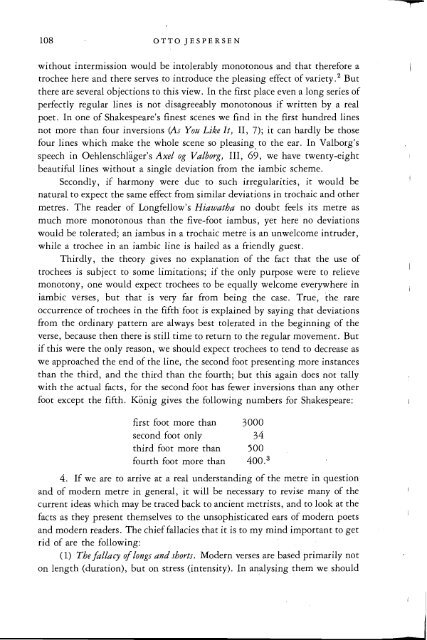OTTO JESPERSEN Notes on Metre - UMR 7023
OTTO JESPERSEN Notes on Metre - UMR 7023
OTTO JESPERSEN Notes on Metre - UMR 7023
You also want an ePaper? Increase the reach of your titles
YUMPU automatically turns print PDFs into web optimized ePapers that Google loves.
108 <str<strong>on</strong>g>OTTO</str<strong>on</strong>g> <str<strong>on</strong>g>JESPERSEN</str<strong>on</strong>g><br />
without intermissi<strong>on</strong> would be intolerably m<strong>on</strong>ot<strong>on</strong>ous and that therefore a<br />
trochee here and there serves to introduce the pleasing effect of variety. 2 But<br />
there are several objecti<strong>on</strong>s to this view. In the first place even a l<strong>on</strong>g series of<br />
perfectly regular lines is not disagreeably m<strong>on</strong>ot<strong>on</strong>ous if written by a real<br />
poet. In <strong>on</strong>e of Shakespeare's finest scenes we find in the first hundred lines<br />
not more than four inversi<strong>on</strong>s (As You Like It, II, 7); it can hardly be those<br />
four lines which make the whole scene so pleasing, to the ear. In Valborg's<br />
speech in OehlenschEiger's Axel og Valborg, III, 69, we have twenty-eight<br />
beautiful lines without a single deviati<strong>on</strong> from the iambic scheme.<br />
Sec<strong>on</strong>dly, if harm<strong>on</strong>y were due to such irregularities, it would be<br />
natural to expect the same effect from similar deviati<strong>on</strong>s in trochaic and other<br />
metres. The reader of L<strong>on</strong>gfellow's Hiawatha no doubt feels its metre as<br />
much more m<strong>on</strong>ot<strong>on</strong>ous than the five-foot iambus, yet here no deviati<strong>on</strong>s<br />
would be tolerated; an iambus in a trochaic metre is an unwelcome intruder,<br />
while a trochee in an iambic line is hailed as a friendly guest.<br />
Thirdly, the theory gives no explanati<strong>on</strong> of the fact that the use of<br />
trochees is subject to some limitati<strong>on</strong>s; if the <strong>on</strong>ly purpose were to relieve<br />
m<strong>on</strong>ot<strong>on</strong>y, <strong>on</strong>e would expect trochees to be equally welcome everywhere in<br />
iambic verses, but that is very far from being the case. True, the rare<br />
occurrence of trochees in the fifth foot is explained by saying that deviati<strong>on</strong>s<br />
from the ordinary pattern are always best tolerated in the beginning of the<br />
verse, because then there is still time to return to the regular movement. But<br />
if this were the <strong>on</strong>ly reas<strong>on</strong>, we should expect trochees to tend to decrease as<br />
we approached the end of the line, the sec<strong>on</strong>d foot presenting more instances<br />
than the third, and the third than the fourth; but this again does not tally<br />
with the actual facts, for the sec<strong>on</strong>d foot has fewer inversi<strong>on</strong>s than any other<br />
foot except the fifth. K<strong>on</strong>ig gives the following numbers for Shakespeare:<br />
first foot more than<br />
sec<strong>on</strong>d foot <strong>on</strong>ly<br />
third foot more than<br />
fourth foot more than<br />
3000<br />
34<br />
500<br />
400. 3<br />
4. If we are to arrive at a real understanding of the metre in questi<strong>on</strong><br />
and of modern metre in general, it will be necessary to revise many of the<br />
current ideas which may be traced back to ancient metrists, and to look at the<br />
facts as they present themselves to the unsophisticated ears of modern poets<br />
and modern readers. The chief fallacies that it is to my mind important to get<br />
rid of are the following:<br />
(1) The fallacy of l<strong>on</strong>gs and shorts, Modern verses are based primarily not<br />
<strong>on</strong> length (durati<strong>on</strong>), but <strong>on</strong> stress (intensity). In analysing them we should<br />
r

















